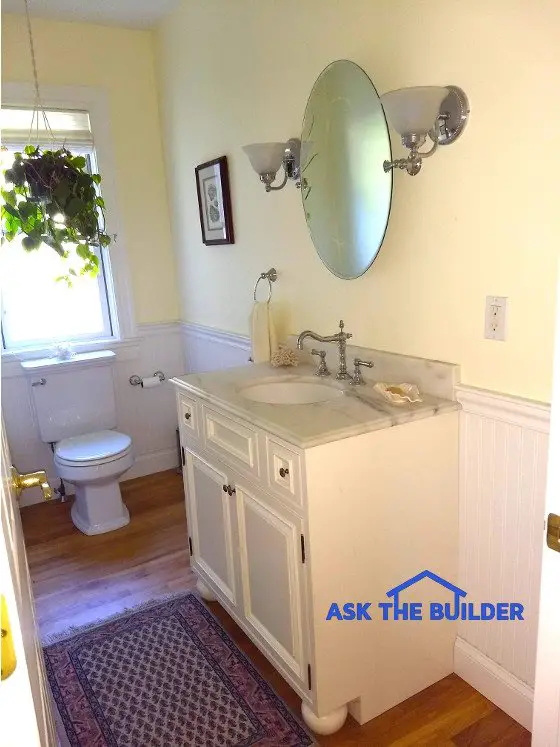Drywall that Gets Wet and Sinks That Fall

I'd use green board drywall in this room because water is not routinely splashed on the walls. (C) Copyright 2018 Tim Carter
Drywall That Gets Wet
Question #1: I need your help Tim. I’ve talked to several contractors and their advice is not in agreement. The dilemma is what drywall should be used in what areas of my house. One contractor talks about green board. Another one mentions MMR board. The third contractor hasn’t heard of either of those two. Help! Can you shed any light on what drywall should be used in my bathrooms, kitchens and other areas where water might get on the walls or ceilings? Debbie T., Boulder, CO
Last week I had a conversation with a homeowner and we wandered into the area of contractor competence. Based on the email I receive each week, I’m certain I have enough evidence to prove beyond a reasonable doubt that there’s a definite downward trend in the level of skill and knowledge in the residential contracting field.
Some of it can be traced to the vast amount of inaccurate information I see out on the Internet. There are hundreds of hobby bloggers who publish this or that on their websites yet they’ve never worked a day in a paying customer’s home. If you wander onto YouTube, you’ll be flooded with videos showing the wrong way to do things. It becomes your job to try to sort out the wheat from the chaff.
When it comes to drywall, fortunately, the answer is easy. One of the top manufacturers of drywall in the USA, USG, has published for decades the bible of drywall and plaster. It’s titled The Gypsum Construction Handbook.
If you open this incredible text, you’ll discover a collection of facts, methods and step-by-step instructions you’ll discover exactly what each drywall product is designed for, how to install it, and where not to use it.
The green board drywall the one contractor mentioned is just like regular drywall, however, the multi-layered facing paper on the front and back has been treated to resist moisture. The gypsum core of the board also contains chemicals to resist moisture. Note I’ve not said the green board is waterproof. It’s NOT waterproof.
It’s not recommended for use in areas that are subject to constant moisture. The handbook gives examples of these areas, but I maintain based on my experience that your tub and shower area would fall into this group. I’d not use green board in a tub or shower area that gets covered with tile.
The MMR board is the new name for green board. It’s an acronym that stands for mold, mildew and moisture-resistant. If you don’t want the tile to fall off the walls in your tub, shower, and kitchen backsplash areas, use a waterproof substrate like cement board or some other product that’s guaranteed to be waterproof.
I’ve got several helpful videos for you at my AsktheBuilder.com website showing the difference between the different drywalls as well as a link to get the Gypsum Construction Handbook. Just go to: Greenboard
Sinks That Fall
Question #2: Tim, we had a disaster in my new kitchen. I was washing dishes and the sink dropped into the cabinet below. It’s an undermount sink with a gorgeous granite top that overlaps the edges of the sink. How could this happen? What do you think went wrong? Can it be fixed with ease? What a mess! Krista C., Salt Lake City, UT
Distraught homeowners like Krista contact me once a month with the exact same problem. Their sinks were installed by unskilled workers who thought caulk would hold the kitchen sink to the underside of the stone tops. Oh how I wish we could rid the workforce of these dunderheads!
Professionals install undermount kitchen sinks using several different methods. My favorite happens to be small machine-thread studs that have a flat head with tiny holes in them. These are permanently affixed to the underside of the countertop with high-strength epoxy. It’s important to realize the underside of the top must be clean and free of all dust for the epoxy to work well. That could have been why your sink fell.
Some installers choose to use a non-epoxy method. A special harness that laps over the sides of the sink base cabinet cradles the sink. Special hardware that’s part of the harness draws the sink up tight against the bottom of the stone top. These systems are usually best installed before the countertop is set on the cabinets.
A professional can come to your home and repair the sink. It’s going to take two days as I’d suggest the epoxy cure for at least 24 hours before you finish re-installing the sink.
I’ve got great videos showing the epoxy studs and harness system at my website. Go to: Undermount Kitchen Sink